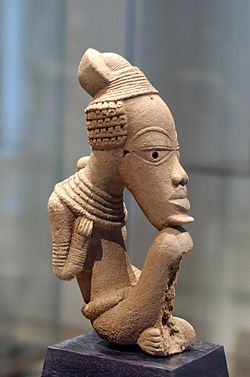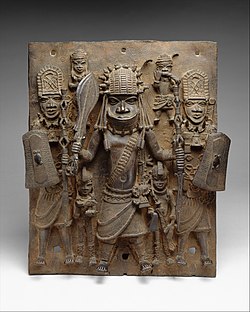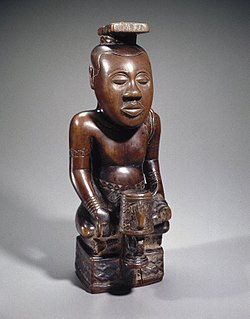
Back Tradisionele Afrika-kuns Afrikaans فن أفريقي Arabic Arte africano AST Afrika mədəniyyəti Azerbaijani Африканско изкуство Bulgarian Afrička umjetnost BS Art africà Catalan Africké umění Czech Afrikansk kunst Danish Afrikanische Kunst German
| History of art |
|---|
African art describes the modern and historical paintings, sculptures, installations, and other visual culture from native or indigenous Africans and the African continent. The definition may also include the art of the African diasporas, such as: African-American, Caribbean or art in South American societies inspired by African traditions. Despite this diversity, there are unifying artistic themes present when considering the totality of the visual culture from the continent of Africa.[2]
Pottery, metalwork, sculpture, architecture, textile art and fiber art are important visual art forms across Africa and may be included in the study of African art. The term "African art" does not usually include the art of the North African areas along the Mediterranean coast, as such areas had long been part of different traditions. For more than a millennium, the art of such areas had formed part of Berber or Islamic art, although with many particular local characteristics.
The Art of Ethiopia, with a long Christian tradition,[3] is also different from that of most of Africa, where the Traditional African religion (with Islam in the north) was dominant until the 20th century.[4] African art includes prehistoric and ancient art, the Islamic art of West Africa, the Christian art of East Africa, and the traditional artifacts of these and other regions. Many African sculptures were historically made of wood and other natural materials that have not survived from earlier than a few centuries ago, although rare older pottery and metal figures can be found in some areas.[5] Some of the earliest decorative objects, such as shell beads and evidence of paint, have been discovered in Africa, dating to the Middle Stone Age.[6][7][8] Masks are important elements in the art of many peoples, along with human figures, and are often highly Stylized. There is a vast variety of styles, often varying within the same context of origin and depending on the use of the object, but wide regional trends are apparent; sculpture is most common among "groups of settled cultivators in the areas drained by the Niger and Congo rivers" in West Africa.[9] Direct images of deities are relatively infrequent, but masks in particular are or were often made for ritual ceremonies. Since the late 19th century there has been an increasing amount of African art in Western collections, the finest pieces of which are displayed as part of the history of colonization.
African art has had an important influence on European Modernist art,[10] which was inspired by their interest in abstract depiction. It was this appreciation of African sculpture that has been attributed to the very concept of "African art", as seen by European and American artists and art historians.[11]
West African cultures developed bronze casting for reliefs, like the famous Benin Bronzes, to decorate palaces and for highly naturalistic royal heads from around the Bini town of Benin City, Edo State, as well as in terracotta or metal, from the 12th–14th centuries. Akan gold weights are a form of small metal sculptures produced over the period 1400–1900; some represent proverbs, contributing a narrative element rare in African sculpture; and royal regalia included gold sculptured elements.[12] Many West African figures are used in religious rituals and are often coated with materials placed on them for ceremonial offerings. The Mande-speaking peoples of the same region make pieces from wood with broad, flat surfaces and arms and legs shaped like cylinders. In Central Africa, however, the main distinguishing characteristics include heart-shaped faces that are curved inward and display patterns of circles and dots.
- ^ Fortenberry, Diane (2017). THE ART MUSEUM. Phaidon. pp. 309, 314. ISBN 978-0-7148-7502-6.
- ^ Suzanne Blier: "Africa, Art, and History: An Introduction", A History of Art in Africa, pp. 15–19
- ^ Ross, Emma George (October 2002). "African Christianity in Ethiopia". The Metropolitan Museum of Art.
- ^ Kino, Carol (2012-10-26). "When Artifact 'Became' Art". The New York Times. Retrieved 2014-12-12.
- ^ Breunig, Peter (2014), Nok: African Sculpture in Archaeological Context, Frankfurt: Africa Magna Verlag, ISBN 978-3-937248-46-2.
- ^ Mitchell, Peter and Lane, Paul (2013) The Oxford Handbook of African Archaeology. Oxford University Press. p. 375. ISBN 0191626147
- ^ Henshilwood, Christopher S.; et al. (2011). "A 100,000-Year-Old Ochre-Processing Workshop at Blombos Cave, South Africa". Science. 334 (6053): 219–222. Bibcode:2011Sci...334..219H. doi:10.1126/science.1211535. PMID 21998386. S2CID 40455940.
- ^ McBrearty, Sally; Brooks, Allison (2000). "The revolution that wasn't: a new interpretation of the origin of modern human behavior". Journal of Human Evolution. 39 (5): 453–563. doi:10.1006/jhev.2000.0435. PMID 11102266.
- ^ Honour & Fleming, 557
- ^ Murrell, Denise. "African Influences in Modern Art", The Metropolitan Museum of Art, April 2008. Retrieved on 31 January 2013.
- ^ Mark, Peter (1999). "Is There Such a Thing as African Art?". Record of the Art Museum, Princeton University. 58 (1/2): 7–15. doi:10.2307/3774788. JSTOR 3774788.
- ^ Honour & Fleming, 556–561


